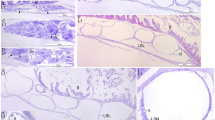Abstract
DE GRAAF1 and more recently Ewer2 have described specimens of Xenopus laevis lacking hæmoglobin. In the course of an investigation on the physiology of the heart of the cyclostome Myxine glutinosa, I found on August 20 an animal about 25 cm. long which was remarkably pale, except in the caudal and dorsal regions, which were grey. Its blood appeared to have no pigmentation due to hæmoglobin except near the gills, where there were some small localized red areas. All the blood vessels were cream in colour as well as the heart, although the ventricle might have been pink (? myoglobin, cytochromes). The liver was dark green and after fixation in 8 per cent formol the principal dorsal vessels showed a light greenish coloration due perhaps to the destruction of hæmin compounds. As for the gall bladder, it did not appear greener than normal.
This is a preview of subscription content, access via your institution
Access options
Subscribe to this journal
Receive 51 print issues and online access
$199.00 per year
only $3.90 per issue
Buy this article
- Purchase on Springer Link
- Instant access to full article PDF
Prices may be subject to local taxes which are calculated during checkout
Similar content being viewed by others
References
De Graaf, A. R., J. Exp. Biol., 34, 173 (1957).
Ewer, D. W., Nature, 183, 271 (1959).
Gustafson, G. J., Ark. Zool., 28, A, No. 2 (1934).
Author information
Authors and Affiliations
Rights and permissions
About this article
Cite this article
RYBAK, B. A Pale Hag-fish. Nature 185, 777–778 (1960). https://doi.org/10.1038/185777b0
Issue Date:
DOI: https://doi.org/10.1038/185777b0
This article is cited by
-
Antarctic fishes survive exposure to carbon monoxide
Experientia (1992)
Comments
By submitting a comment you agree to abide by our Terms and Community Guidelines. If you find something abusive or that does not comply with our terms or guidelines please flag it as inappropriate.



